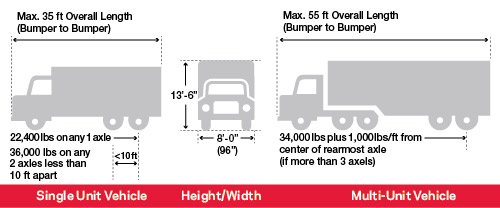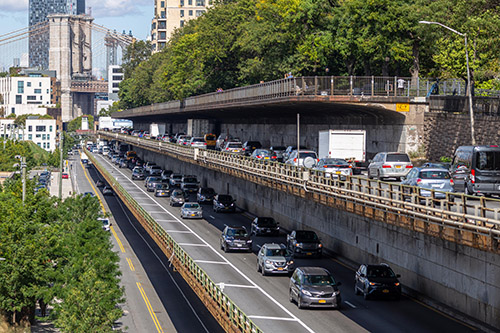Size and Weight Restrictions
On this Page
Commercial vehicles are not permitted to travel on parkways. All commercial drivers must use Local and Through truck routes to the intersection nearest their destination. All posted restrictions must be obeyed. Vehicles exceeding any of these dimensions must obtain a daily over-dimensional vehicles permit for each trip (going and coming back). Apply for a daily permit for over-dimensional vehicles

Tractor-trailer vehicle combinations not exceeding 13′6″ in height, 8′ in width, and 55′ in length can travel on interstates and truck routes. The maximum allowed length of single unit vehicles, such as box trucks, is 35′.
Federal STAA vehicles (pdf) not exceeding 13′6″ in height, 8′6″ in width, 48' trailer length, and the lower of the bridge formula weight or 80,000 pounds, moving household goods can travel on interstates and truck routes. STAA vehicles not moving household goods are limited to one-mile access to and from the exit.
Trucks with 53-foot trailers may only travel on the portions of I-95, I-695, I-295, and I-495 that cross the city between the Bronx-Westchester County line and Queens-Nassau County line. 53-foot trailers carrying non-divisible loads must apply for a New York City Permit.
Maximum weight limit for vehicles is 80,000 pounds or less, depending upon axle spacing. Bridges or viaducts may have lower weight limits posted. The legal weights are outlined below. See Section 4-15 (b) (6) thru (10) of the Traffic Rules for more details.
All vehicles must obey posted capacity or height clearance of all structures.
Legal Weights For Trucks with Pneumatic Tires1
| Wheels/Axles | Weight |
|---|---|
| Per Inch of Tire Width | 800 lbs |
| Any One Wheel | 11,200 lbs |
| Any One Axle | 22,400 lbs |
| Any Two Axles2 | 36,000 lbs |
| 3 or More Axles | 80,000 lbs3 |
- A vehicle equipped with solid rubber tires is permitted up to 80% of legal load for pneumatic tires.
- When such axles are spaced less than 10 feet, but not less than 4 feet 6 inches.
- Maximum weight limit is computed as 34,000 lbs, plus 1,000 lbs per foot of distance between the first and last axles. 80,000 lbs is the outer limit for all cases.
Weigh-In-Motion
Weigh-in-motion (WIM) devices capture axle weights and gross vehicle weight of moving vehicles. Vehicles do not need to be stopped to be weighed. This technology offers a more efficient method to weigh vehicles and provides useful data.
The BQE Weigh-In-Motion Program

The New York State Legislature authorized a first-in-the-nation automated WIM enforcement system of truck weight limits on the New York City-owned portions of the Brooklyn-Queens Expressway (BQE). NYC DOT WIM sensors installed on the roadway are synced with license plate cameras to issue citations for vehicles found in violation. The new program will help better enforce existing state laws designed to preserve the life span of roads and bridges and build upon targeted enforcement efforts by the NYPD.
The new automated enforcement program on the BQE was made possible by the enactment of S6246/A6225 sponsored by Senator Andrew Gounardes and Assembly Member Jo Anne Simon and signed by Governor Kathy Hochul in July 2023.
As defined in the legislation, the enforcement program only applies to the City-owned section of the BQE from the vicinity of Atlantic Avenue to Sands Street in Brooklyn.
The BQE is a critical regional transportation and economic artery, and swift implementation of automated enforcement will help to deter overweight trucks from putting additional wear and tear on this aging piece of infrastructure as New York City develops a long-term repair plan. Learn more about BQE Corridor Vision at nyc.gov/bqe.
The City began enforcement of the BQE WIM system in the Queens-bound direction on November 13, 2023, following a 90-day warning period that began in August 2023. Overweight trucks on the Queens-bound direction will be subject to a $650 fine per violation. Installation for the Staten Island-bound direction is anticipated to start in the coming months with a 90-day warning period to follow.
BQE Automated Weigh-in-Motion Enforcement presentation to trucking industry – August 2023
BQE Weigh-In-Motion Program FAQ
Automated Enforcement of Truck Weight Limits on the BQE (Abridged Version)Why are weight limits important?
The BQE is subject to the same federal and state legal truck weight limits as all other roadways. These limits are in place to ensure that roads and bridges can operate safely under normal traffic conditions. Excessive overloads reduce the life span of our infrastructure.
What is the penalty for driving an overweight truck on the BQE that is identified by WIM cameras and sensors?
Each violation has a penalty of $650. The penalty could be for exceeding gross vehicle and/or axle or tandem weight limits.
How will the new automated enforcement of weight limits work?
Governor Kathy Hochul signed a bill in July 2023 that allows the City of New York to use WIM sensors on City-owned portions of the BQE to help enforce truck weight limits. License plate cameras will be synced with the weight sensors to identify overweight trucks and issue tickets to the registered owner of the vehicle.
When will WIM sensors go-live and when will enforcement begin?
The BQE WIM system is currently in place in the Queens-bound direction and enforcement began on November 13, 2023, following a 90-day warning period that started in August 2023. Installation for the Staten Island-bound direction is anticipated in the coming months and will be followed by a 90-day warning period.
How do WIM sensors work?
WIM sensors are systems installed in roadways that determine a vehicle's gross weight and axle weights while it travels over the roadway.
What are the truck weight limits in New York City?
Who should I contact if I have questions about the program?
How many sensors? Where are they?
Weight sensors will be placed on the BQE in the vicinity of Atlantic Avenue to the vicinity of Sands Street in both directions. There will be two independent sets of sensors as required by legislation, to capture both gross vehicle weight and axle weight. The weights will be shown in the violations.
What if my vehicle is carrying an indivisible load?
Vehicles that exceed legal limits need to apply for an over-dimensional vehicle permit with NYC DOT, which includes a routing map. Permits issued by NYC DOT already direct trucks away from the BQE.
How will the accuracy of the system be verified?
NYC DOT WIM sensors will be calibrated and certified every six months as required by the authorizing legislation for the WIM automated enforcement program. The calibration certification will be conducted by the New York State Department of Agriculture and Markets. This standard procedure is used for portable scales and other enforcement devices.
Which violations are detected and enforced with the automated weight enforcement program?
This program detects and issues violations to vehicles exceeding the allowable weight limits traveling on the BQE from the vicinity of Atlantic Avenue to Sands Street. This will be enforced on vehicles exceeding gross vehicle weight limits as well as axle weight limits. Review the details above for additional information on truck weight restrictions.
What if I receive a warning that I believe was issued in error?
Warning notices do not carry a fine and will not accrue points or any other liability on your vehicle registration. There is no need to dispute a warning notice. However, you may contact NYC DOT online to provide feedback on the warning notice.
What if I receive a violation that I believe was issued in error?
If you receive a violation that you believe was issued in error, please follow the instructions on the notice of liability to dispute the violation. You may dispute the violation by contacting the New York City Department of Finance online, by mail, or in person.
Overweight trucks are driving on my street. How do I request enforcement? Can WIM be used there?
If you suspect there is an overweight truck on your street, you may call your local precinct. NYC DOT's WIM program is a pilot only authorized to operate on the BQE from the vicinity of Atlantic Avenue to Sands Street.
Are there any plans to expand the program in the future?
NYC DOT is committed to fostering a culture of compliance for truck rules and regulations. NYC DOT will evaluate the need to expand based on the performance of the pilot program. Additionally, NYC DOT is working towards building a network of screening sites citywide to monitor overweight trucks.
What steps are being taken to educate trucking companies and drivers about the program?
The agency's goal is to prevent overweight vehicles from ending up on the city's roadways in the first place. NYC DOT is working with the trucking industry to educate commercial vehicle and truck operators about weight limits and the enforcement program.
Will the program be integrated with other enforcement initiatives?
NYC DOT is working with NYPD and other partners to identify and target enforcement along other corridors that overweight trucks without a permit may try to use as an alternative.
Are there any exemptions or special provisions for certain vehicle types?
Trucks that exceed the allowable weight limits must apply for an over-dimensional vehicle permit from NYC DOT. Limits are in place to ensure that roads and bridges operate safely under normal traffic conditions. Due to the need to extend the life span of the BQE as a critical corridor, no overweight vehicles – with or without a permit – are allowed to travel on the BQE between Atlantic Avenue and Sands Street.
